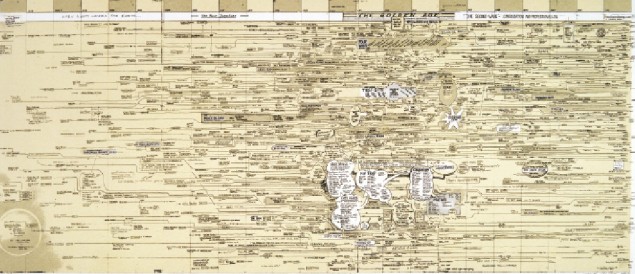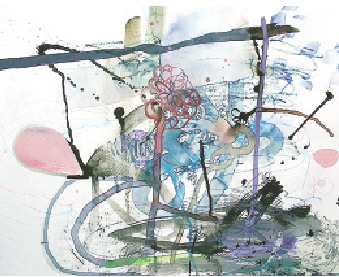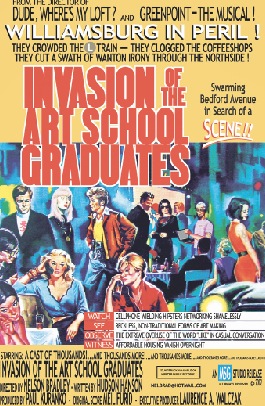
Ward Shelley’s “Williamsburg Timeline Drawing,” 2002, serigraph.
Larry Walczak has seen a whole lotta changes in Williamsburg’s gallery scene since he arrived here in 1994. Eyewash—the gallery he ran with the late Annie Herron from 1998 to 2002 on Williamsburg’s Northside—gave first starts to a host of local talents: Bruce Pearson, Eric Heist, Angela Wyman, Adam Simon, Ward Shelley, Greg Stone, David Kramer, David Brody… Recognize them? If not, you ought.
They were the artists who lived and worked here in the late ‘80s and early ‘90s who laid the foundations of today’s bustling scene. This month he’s opening an ambitious and utterly subjective exhibition called “Williamsburg2000” in which he alternately waxes nostalgic and gets his inner activist on. On tap will be 50+ artists he’s worked with at eyewash over the years, first on North 7th Street, and later in places far and wide—after the Buildings Department closed eyewash and he transformed it into a “migratory gallery.”
Read on as we pick Walczak’s brain over tea. We ask him to conjure up visions of ten (!) years ago, as well as look into his crystal ball and see what the future holds for artists with a dream—but not a lot of dough.
Tell us about the year 2000 and why you want to pay homage to that milestone in particular. I feel like that year was the culmination of the powerful [visual-arts] energy in the neighborhood that started way back in the late ‘80s. More local creative people got to exhibit their work than ever before; we had a consistent flow of writers, collectors; visitors came from Europe and Asia. All this fueled a really healthy productive gallery scene, most all of it artist-run.
What was your gallery on N 7th like: the physical space, the vibe? Set the scene. Eyewash is a gallery that existed from 1998 to 2002, [housed] in a four-story apartment building built in 1910 at 143 North 7th Street. I had access to one or two vacant apartments I could use as a gallery or installation space. By the third exhibition, Annie Herron joined me as a co-director. We were able to afford artists a domestic setting for their installation work: these were floor-through apartments with 11-foot ceilings and very spacious. There were pine floors, large windows. We hung artwork in the kitchen inside of cabinets, even in the bathroom.
Describe a major show in eyewash’s heyday. The “Valentine ‘99” show. Many of the artists that were in that show are in this show, as it turns out. The idea was artist valentines and or collaborative works done by [artist] mates or lovers. Joe Amrhein and Susan Swensen [who run Pierogi gallery] did a piece; James Esber and Jane Fine; Ken Butler and Jenny Lynn McNutt; Lisa Hein and Bob Seng. That show had an article in the New York Times. A film crew from Sweden documented it for Swedish television. Big crowd. Sunday afternoon. Our third show. That was a heyday. You get a piece in the Times and that morning people will come. Nothing works like the Times.

Jeanne Tremel’s “Ditmas07,” mixed media on paper.
Let’s imagine we went to that show and now we’re outside, on the street. What would we see? The only coffee shop was the L Cafe on Bedford Avenue. Planet Thailand was the only place to go for Thai food. [If you wanted to see galleries] you could do a one-afternoon tour of the Northside, Southside, have a nice lunch at Oznot’s. Chelsea was just starting out, so we’d get a lot of Manhattanites on a Sunday.
What was the bar to go to? Let’s see, The Ship’s Mast was closed by then, long closed. Teddy’s, that’s always been a staple for burgers and beer and is kind of like a neighbor-hood bar because Felice Kirby (who runs it) is such a community activist. The Blue Lounge on Driggs and North 8th was a place we hung out. It’s long gone; it’s a liquor store now. Galapagos was on North 6th. You could probably count the places to go on both hands.
Can you estimate the hipster density? There weren’t hipsters then; it was rock and rollers and artists. You’d see black leather jackets and boots on Bedford Ave. Nerdy black-rimmed eyeglasses. Annie started wearing bib overalls and that sort of caught on.
Tell us about Annie, your partner, who passed away in 2005. Annie was my partner; she was my gallery partner and my life partner. She was the most generous spirit that I’ve ever known. She was also a complete professional when it came to installing shows; she was a perfectionist. We’d keep changing the show taking it down and putting it up until we’d get it right. She had been a curator for many years; she was director of Semaphore East in the East Village, then went on to Soho to open Black + Herron Gallery [with Barrie Black], and then opened the first commercial gallery in Williamsburg called Test-Site in 1992, on North 1st between Berry and Wythe.
There are a lot of people reading this who won’t know anything about The Salon of the Mating Spiders—the now-legendary show at Test-Site in 1992. That was the show that brought the whole art community out. There was a line going from the gallery all the way down the block. It seemed every artist hidden away in the North and South side came out to participate. Annie wanted her first show to be as inclusive as possible, so she felt that they could hang every piece that was submitted. And they came and they came. Ken Butler (local musician, artist, longtime W’burg resident) tells a story about how he was playing at the opening outside on the street on North 1st and looked up at the crowd and thought to himself, “I feel like I’m playing at Woodstock.” You suddenly realized just how big the art community was.
What were openings at Test-Site like? They weren’t openings, they were a scene, all-night affairs. Roast beef sandwiches and salads, imported beer. Live bands. They Might Be Giants would play—they lived right around the corner. You’d see all your neighbors when you went.

Nelson Bradley’s “Invasion of the Art School Graduates,” 2002, poster.
The news cycle has definitely affected the art scene here. Can you pinpoint some headlines that rang the knell of “gentrification” or just spelled “change”? The New York Magazine cover story in 1992 that declared “The New Bohemia” and then in a smaller subtitle: “Across the River to Williamsburg” and featured people sitting outside the Right Bank Cafe on Kent Avenue. Roberta Smith’s “Haven for Artist’s” article came out in the Times in 1998. It was a Friday. That Saturday morning I could remember opening my window and seeing a limousine pulling up outside. People were coming up to the gallery that had never come before. People were pointing things out and asking “How much is that?” Time Out New York’s “The Ultimate Party Guide to WILLIAMSBURG” issue in February 2000. That opened the floodgates to the party kids, and hipster central. Last year, the New York Times Magazine called Williamsburg a “music neighborhood,” not an art neighborhood. It was about how bands are living here and people are coming to see bands. Of course people called it “the next Soho” or whatever [back when] and now that’s totally gone.
What’s the landscape like for a new grassroots scene here in 2010? Wburg is limited by what’s happened in the real estate market; you have to buy a building here now. You can’t get cheap, affordable space to do experimental instal-lations. If you want to start a gallery now, you need a business plan.
Has any of the good energy that was in the Williamsburg2000 era shifted? Where has it gone now? A lot of the energy I saw in the 2000 era seems to be the energy I see in Bushwick today. However, having visited a number of galleries, I can say that their shows remain highly inconsistent, and it may be many years before their shows mature. Things in general are pushing east into Brooklyn. It’s a huge borough and I’d have to endorse Brooklyn as the next big borough-wide gallery scene. People are buying places in Bed Stuy. That’s what I should have done in Williamsburg in 1994.
Do you have any advice for young artists trying to make their mark today? For aspiring curators, I’d say to get out there, find an affordable workable space and do it. If you’re an artist, I’d say: don’t be afraid to try your hand at curating, meeting other artists, and making shows happen that you would like to see. I did.
Williamsburg2000 is at Art 101 located at 101 Grand Street.
It opens on March 12th and runs through April 17th.
Gallery hours are Fri–Sun 1–6PM.
Leave a Reply